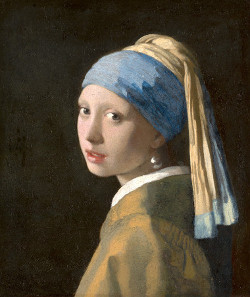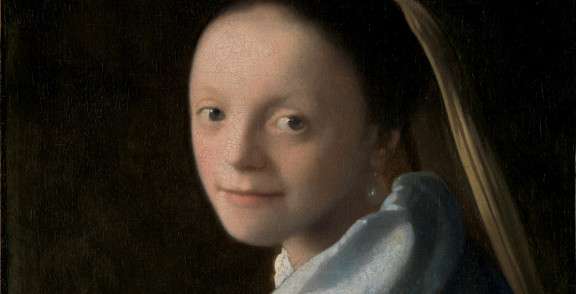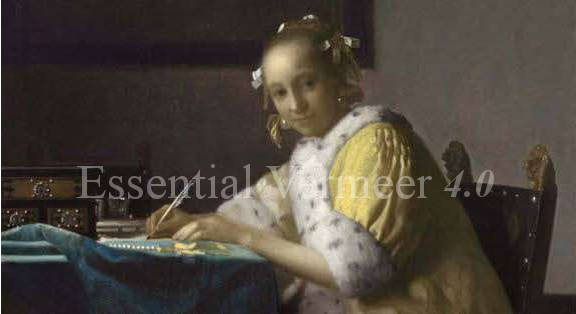No. 38 "A tronie in antique dress, uncommonly artful, by the same" 36-0
No.39 "Another ditto by Vermeer" 17-0
No. 40 "A pendant by the same" 17-0

Girl with a Red Hat
Johannes Vermeer
c. 1665–1667
Oil on panel, 23.2 x 18.1 cm.
National Gallery of Art, Washington, D.C.
The term tronie, which derived from the French "trogue," refers to "heads" or "faces" paintings which had been popularized by Rembrandt and his followers. Even though the tronie represents a bust length single figure and was usually painted from life, it is not a portrait in the seventeenth-century meaning of the word. In contemporary usage, tronie might cover any picture of an unidentified sitter, but in modern art-historical usage it is typically restricted to figures who do not seem to have been intended to be identifiable. The tronie furnished the artist an opportunity to demonstrate his ability in rendering fine stuffs, an exotic garment or characteristic facial type that struck him as unusual. The artist wearing exotic headgear, the dashing soldier or the "Turkish archer" were favorite tronien. Vermeer's Girl with a Red Hat, Girl with a Pearl Earring and Study of a Young Woman would have been all be considered tronien, not portraits. Tronien were probably sold on spec. The tronie, then, "with its anonymous models doing and meaning next to nothing, was perfect for collectors who wanted an affordable proof of the technical mastery of a given painter.."1

Study of a Young Woman
Johannes Vermeer
c. 1665–1667
Oil on canvas, 44.5 x 40 cm.
Metropolitan Museum of Art, New York
Painting no.38 of the Dissius catalogue has often been thought to refer to Vermeer's iconic Girl with a Pearl Earring, presently in the Mauritshuis. Although its price was not as high as one may expect (only 36 guilders), in reality tronien normally did not command high prices. Even a Rembrandt tronie in the same sale (no. 45) fetched only 7 guilders and 5 stuivers. Johan Larson, a Hague/London sculptor, had in his collection a Vermeer tronie which was valued at only 10 guilders. However, Vermeer's chief biographer John Montias believes that the Larson tronie was most probably the much smaller Girl with a Red Hat . The Study of a Young Woman with painting no. 38, which was sold for less than half the price of no. 39.
Iit should be remembered that Vermeer's contemporaries sometimes valued painting differently than we. For example, Vermeer's large Allegory of Faith in the Metropolitan Museum of Art, which is today considered coldly distant in its classicism, was paid 400 guilders only three years after the magnificent View of Delft was sold for 200 guilders. In the same auction The Milkmaid was paid 175 guilders while The Music Lesson, now considered one of Vermeer's highest artistic and technical achievements, paid less than half that price (80 guilders).

Girl with a Pearl Earring
Johannes Vermeer
c. 1665—1667
Oil on canvas, 46.5 x 40 cm.
Mauritshuis, The Hague
It is possible that the Girl with a Flute and Girl in a Red Hat refer to the two pendant pictures of list number 40.
† FOOTNOTES †
- Groningen Lyckle de Vries, review of "Tronie und Porträt in der niederländischen Malerei des 17. Jahrhunderts," Hirschfelder, Dagmar, Berlin 2008, in H-ArtHist, Feb 9, 2011. http://arthist.net/reviews/887




 or anything else that isn't working as it should be, I'd love to hear it! Please write me at:
or anything else that isn't working as it should be, I'd love to hear it! Please write me at: